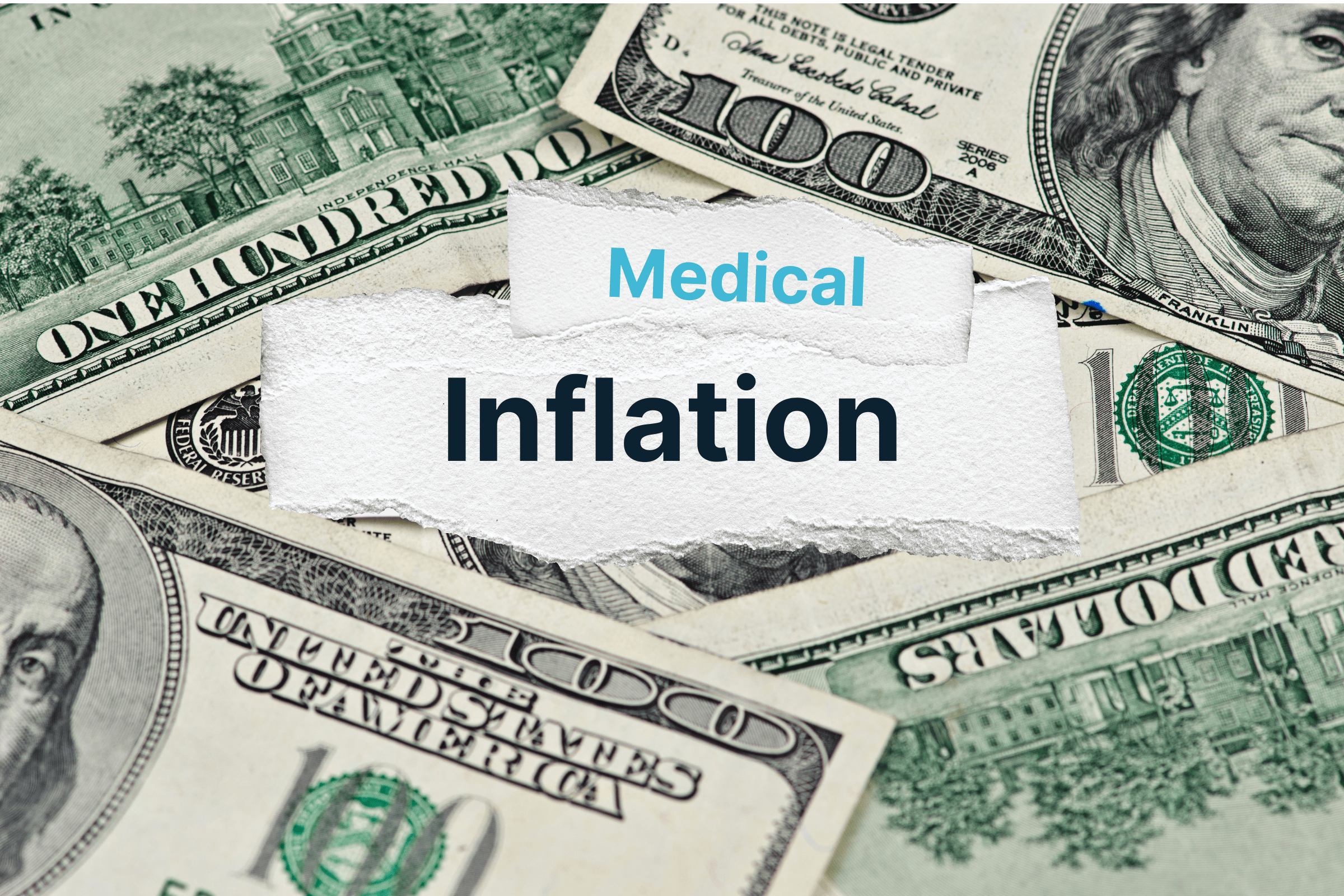Why Healthcare Costs Are Rising for Employers in 2024
Learn about medical inflation, rising provider costs, and other factors that are driving healthcare costs up for employers in 2024 and beyond.
Health insurance costs are squeezing employers across the U.S., especially in Hawaii, where employer-sponsored health insurance is mandatory for businesses of all sizes, according to state law. But health insurance is one of the top benefits employees look for when making employment decisions. What should local businesses do? How should employers balance rising healthcare costs amidst talent pressures? In this blog post, we look at market and workforce trends affecting both rising healthcare costs and persistent attraction and retention challenges in Hawaii and discuss how employers can make the most of their healthcare offering to balance both concerns.
The Main Culprit in 2024: Medical Inflation
After a decade of lower inflation rates (<3%), general inflation rose significantly (8%) in 2022, and made a big dent in the wallets of many local families and businesses. Last summer, Hawaii's gas prices hit record highs at $5.34 for regular unleaded gas, the state's main staple — rice–jumped $2 for a 25-pound bag, and utilities began to soar.
Medical inflation, however, differs from general inflation. According to Milliman, medical inflation lags general inflation by 7-13 months, and its impact (usually 2% higher than general inflation) has yet to make its way to employers' pocketbooks. In other words, while businesses and consumers alike are glad to see general inflation finally coming down in 2023, medical inflation is preparing to make its grand entrance. And it will likely impact premium rates starting in 2024.
3 Key Drivers of Medical Inflation in 2024
What's driving up costs? This next section will cover the three critical inflators contributing to medical inflation in 2024 and other ongoing drivers of costs. What's important to note are the many interrelated factors, including lag patterns, that influence medical inflation and contribute to the rise and timing of healthcare costs and its impact on employer wallets.
#1. Underlying Provider Costs
In recent years, it has become increasingly expensive for healthcare providers, like hospitals, to provide patient care. The surge in labor costs, exacerbated by the shortage of healthcare and clinical workers, is one of the main reasons. According to a recent PwC report, U.S. hospitals saw ~16% increase in labor expenses due to paying higher wages to retain burned-out workers and using temporary staff through “traveler agencies.” Hawaii’s shortage of healthcare workers is particularly pronounced, with 4,000 vacancies in the field. It has already led to several successful healthcare strikes, raising wages for Kaiser mental health employees and healthcare workers in Maui County in 2023.
In addition to labor costs, real estate and new building projects undertaken by hospital systems further accentuate the financial burden providers face, ultimately affecting healthcare services' overall cost. In Hawaii, for instance, Queens Medical Center initiated a $500 million expansion project in West Oahu this year, scheduled to span over 15 years. The expansion entails increasing the west campus's size from 250,000 to 1 million square feet and adding 260 more patient beds, growing the total from 104 to 364 beds. Similarly, Straub Medical Center began constructing a new state-of-the-art campus in January 2023, with a staggering value of $1 billion. These ongoing infrastructure investments signify the dedication of healthcare providers to enhance their capabilities and meet the state’s healthcare needs. However, they also contribute to the rising underlying costs borne by providers, playing a significant role in the challenges of medical inflation.
Note for employers: In 2024 and beyond, health insurance companies will need to consider the inflationary impacts on healthcare providers as they respond to mounting pressures to increase reimbursements for the growing costs of medical services. The process is time-consuming, as contracts must be renegotiated to reflect the actual costs and then be reviewed by insurance carriers. Subsequently, incorporating these cost increases into premium rates offered to employers also requires additional time. Significant cost growth may start in 2024, but employers should plan ahead and add substantial padding to their healthcare budgets in the years to come.
#2. Drug Prices
Soaring drug costs are another key factor contributing to medical inflation in 2024. According to a survey of large employers, prescription drugs accounted for 21% of employers' healthcare costs in 2022, in which specialty medicines drove over 50% of those costs. This cost trend only continues. In January 2023, drugmakers raised prices on nearly 1,000 drugs this year, the highest hikes sought by manufacturers since 2011. According to PwC, this cost trend is driven by specialty drugs and the growing use of GLP-1 agonists, such as Trulicity and Ozempic, for managing Type 2 Diabetes or weight loss.
In Hawaii, the impact of rising drug costs is particularly significant due to the large population of people with diabetes. According to the John A. Burns School of Medicine, 13% of Hawaii's adult population has diabetes, representing approximately 1 in 9 adults. In comparison, the prevalence of diabetes in the entire U.S. population stands at 11.3%. This higher concentration of diabetics in Hawaii magnifies the challenge posed by increasing drug costs, further contributing to the state's medical inflation in 2024.
#3. Pandemic & Delayed Care
Finally, the pandemic has caused various shifts in healthcare utilization and patient behavior, impacting medical inflation. During the pandemic, people tended to cancel or defer their healthcare appointments and treatments, leading to a backlog of care that has resulted in more extended hospital stays and higher severity of conditions upon diagnosis. According to a 2023 report, patient severity has been up 5% since 2019, while the average length of stay for admitted patients has risen 10%. Increased patient acuity, according to the American Hospital Association, has caused increases in hospital labor, drug, and supply costs, creating many financial challenges for providers.
A survey of large employers further confirms these trends, with 43% of employers witnessing an increase in medical services due to delayed care and 21% seeing heightened disability claims due to long COVID.
Other Factors Employers Should Consider
Aging Population
Like many other regions, Hawaii is witnessing an aging population seeking better medical care and living longer lives. Baby Boomers, born in the 1950s and 60s, are now in the 60-70 age group, resulting in a higher demand for medical services and healthcare resources. As individuals age, they often require more frequent medical interventions, and increased healthcare utilization–subsequently driving up costs for employers providing healthcare benefits to their employees. Furthermore, Hawaii boasts the highest life expectancy for people over 65 in the U.S.
Increase in Chronic Diseases
In Hawaii, chronic diseases such as heart disease, cancer, lower respiratory disease, and diabetes, are the leading causes of death in the state. Their ongoing management often results in higher utilization of healthcare services and costs to everyone involved, including employers. One survey of employers revealed that 34% of employers experience a rise in healthcare costs due to increased chronic disease prevalence.
Growing Mental Health Crisis
Lastly, the pandemic has also triggered a surge in mental health issues, including depression, anxiety, and substance use disorders. The social isolation, uncertainty, and fear brought about by the pandemic have had lasting effects on the mental well-being of employees. Although mental health services saw a significant uptick in utilization during the pandemic, a report by PwC highlights that its cost remains relatively lower than other medical services. Still, it's something employers are seeing, evidenced by an Aflac 2023 survey, where 42% of employers reported increased benefit costs in the past year due to heightened mental health incidents.
Takeaway for Hawaii Employers
Many factors contribute to the rising healthcare costs for employers in 2024, with medical inflation as a key driver. The increasing costs of treating patients, driven by rising provider expenses and surging drug prices, are putting considerable financial strain on healthcare systems and insurers alike. Additionally, the impact of the pandemic has led to deferred care, longer hospital stays, and a surge in mental health issues, further contributing to the upward trajectory of healthcare expenses.
Amidst these challenges, two core truths emerge: firstly, treating patients is becoming more expensive, and secondly, people are living longer but not necessarily healthier lives. As we approach 2024 and beyond, Hawaii employers must acknowledge these realities and prepare for higher healthcare costs due to medical inflation in the coming months and years.
Employers can proactively address these challenges by budgeting more for healthcare expenses and exploring the implementation of preventative wellness programs. Promoting employee well-being and encouraging healthier lifestyles, particularly in areas like diabetes management, can improve overall health outcomes for their workforce and may also help mitigate long-term cost impacts on employers.









